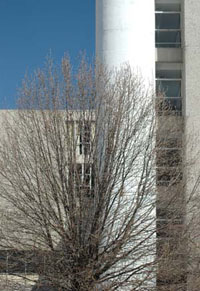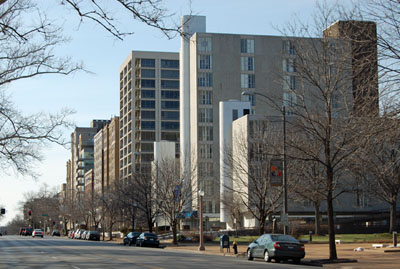Board Statement on the De Ville Motor Hotel (San Luis Apartments)
March 18, 2008
The following resolution was adopted by Landmarks' Board of Directors on March 14, 2008:
The Board of Directors of Landmarks Association of St. Louis, Inc. urges retention and rehabilitation of the former de Ville Motor Hotel at 4483 Lindell Boulevard. Designed by Colbert, Lowery, Hess & Boudreaux of New Orleans and completed in 1963, the building is a strong example of mid-century modern architecture. Through curvilinear forms and differentiation of wall materials, the hotel possesses a striking geometric presence. With covered parking placed in the rear away from Lindell Boulevard, the Hotel de Ville promotes the pedestrian-friendly quality of the Lindell streetscape.
Additionally, the building is a complementary member of a collection of modern buildings around the intersection of Lindell and Taylor, including Lindell Terrace to the west, the Archdiocesan Chancery to the east and the Optimists' Club building to the south. Most recently, the San Luis Apartments, the building maintains the street wall on Lindell, enhancing the context of the Cathedral. Loss of the buildings for a surface parking lot would dramatically demean this context. Thus, the Board emphatically opposes the creation of a surface parking lot on Lindell Boulevard in the Central West End Historic District.
At the point when the Board passed the resolution, we had found only basic information about the $5 million motor hotel developed by Harold and Melvin Dubinsky in partnership with New Orleans construction giant Paul Kapelow. So on Friday March 14, Landmarks researcher Lindsey Derrington sent an email to the New Orleans Chapter of the American Institute of Architects explaining the St. Louis situation and requesting information about the architectural firm of Colbert, Lowery, Hess & Bouderaux. On the following Monday morning we received a "jackpot" reply from Melissa Urcan, the Executive Director of AIA New Orleans:
We here in New Orleans certainly know a thing or two about the disrespect for Modern architecture. In a city far more known for its earlier forms of historic buildings, all of the great work done here in the 50s and 60s is often overlooked. Sadly now after Katrina many of these buildings are also slated for demolition, many without [a] word's notice. I curated a show called Regional Modernism at the Ogden Museum of Southern Art last year in the hopes to better educate the public about our many fine works of Modern architecture in this region.
Charles Colbert was elected a fellow of AIA in 1961, and received the Medal of Honor award from AIA Louisiana in 2007, also championed by our chapter. Colbert wrote three books, many articles, was the dean at Columbia for two years, taught at numerous universities throughout his life, and designed a number of notable buildings in this region. Charles Colbert's work was prominently featured in the exhibition Regional Modernism, mentioned earlier.
 |
| Photo by Gary R. Tetley |
Colbert had already designed three motel hotels (one in New Orleans, Shreveport and Denver) at the point when the Dubinskys and Kapelow engaged him for their St. Louis project. Opened on July 3, 1963, the E-shaped Hotel de Ville boasted 226 guest rooms (each with individual temperature controls), 180 parking spaces, meeting rooms, a sunken swimming pool plaza, three dining areas and a lounge. In contrast to his low-slung New Orleans project, Colbert responded to the high-rise context on Lindell by employing an eleven-story central tower flanked by five-story towers. All were clad in concrete panels imbedded with quartz crystal aggregate designed, as the press noted, to sparkle in the sunlight.
In December of 1966 the multimillion-dollar property was purchased by a corporation headed by Joseph H. Vatterott and re-opened as the fifth Holiday Inn in greater St. Louis operated by his management company. Vatterott said purchase of the almost new hotel reflected confidence in the future of St. Louis as a business, commerce and tourist center. "We believe that the revitalized spirit of St. Louis as symbolized by the Gateway Arch and the new Busch Memorial Stadium and other progressive developments has shown that St. Louis is a city on the move and is rapidly growing toward becoming the center of progress in the Middle West." (St. Louis Globe-Democrat, December 2, 1966.)
Forty-some years later we lost Busch Stadium-one of the foremost icons from a brief moment in our architectural history when excellence in contemporary design was valued as an expression of civic achievement. The former Hotel de Ville is not Busch Stadium. It is, however, clearly eligible for listing in the National Register of Historic Places within just a few years: It is significant as the work of a master architect, as a splendid model of how new construction can fit comfortably into an existing context and as an exemplar of an urban hotel designed to respect the streetscape yet accommodate the automobile.
The Central West End Association has scheduled a public meeting at the Schlafly Branch Library on Saturday, March 29th at 9:30 a.m. Members of LANDMARKS staff and Board plan to be there.

